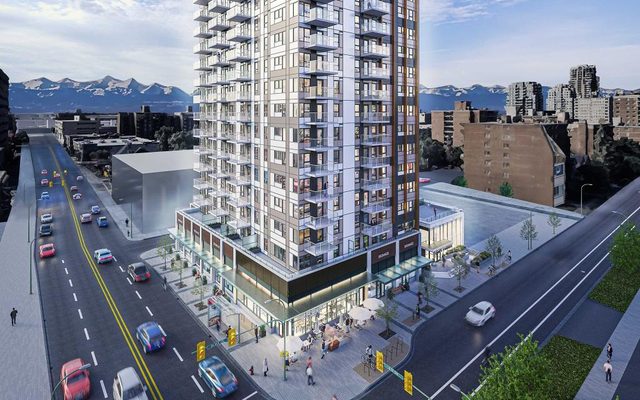Baker Real Estate has long been a leader in Canada’s preconstruction condominium sales and marketing. But as the market shifted, Baker adapted, launching a new purpose-built rental division earlier this month to lend its expertise to the increasing interest in rental development.
Baker named Todd Nishimura as vice president of the new division. Formerly the senior director of leasing, marketing and communications at GWL Realty Advisors Residential, Nishimura brings more than a decade of experience in residential leasing.
Green Street News spoke with Nishimura and Baker’s president, Harley Nakelsky, to learn more about the new division and the future of rentals in Canada.
You’ve said the PBR division is something you had thought about doing for years, but did the slowing condo market accelerate your plans at all?
Nakelsky: Yes, it did. My wife recently reminded me that we talked about it six or eight years ago, but I think that we’ve been so busy selling condos that we haven’t given this enough time. And yes, as the real estate market has slowed down, it was the right time to jump in.
There’s also — because of the slowdown and the government regulations and different promotions they’ve put in place to help developers build purpose-built rental — there are a lot of developers who are our clients now really looking at purpose-built rental, and that’s where it makes more sense than ever for us to get involved.
And you know what’s funny? For years, we actually made a lot of money taking buildings that were supposed to be purpose-built rentals and selling them as condos. The number of condo projects we sold in the past that were originally supposed to be purpose-built rentals is a significant number, and the math has now penciled in the other direction.
Can you break down what exactly the new division will do?
Nakelsky: On the preconstruction front, we can get involved at the start, and we work with the developer on unit mix, on unit sizing, on floor plans and how that marketing plan and strategy will roll out — the right branding, hitting the right demographic, all the different pieces.
Then we’re working with them on the planning as they get to renting. You know, how do you set up a rental office? When do you do it? There are all these different pieces that we talk about on how to get better absorption and fill these units, and we take them through the entire lease-up period until we turn over the keys to a property manager.
How far out are you able to start the leasing process, especially when dealing with developments that are under construction?
Nishimura: I think the initial reaction, if you’ve not been in rental, is to start advertising a year out before first occupancy. And there’s nothing wrong, really, with doing that, but what I like to say is you could sign a blood oath saying, “I’m going to move in in 12 months,” but your life could change dramatically in that period of time and would just preclude you from being able to do that.
You get married, you get divorced, you get a new job, etc. So, all that being said, I think the way to be most effective and efficient with your marketing spend is to start advertising about six months prior to first occupancy, and then start signing leases 90 days before first occupancy.
Demand for rentals is up. Are you still seeing developers having to offer rental move-in incentives?
Nakelsky: I think this is a problem with the condo market and probably the rental market a little bit right now. We’ve had more deliveries than we have seen in a very, very long time, if not ever, so there is a lot of product on the marketplace right now.
That is why, I think, there are a lot of people trying to figure out how to either fill their purpose-built rentals, which we’re happy to help with, or lease out your suite, however you’re doing that. So, I do think that that’s causing more of these incentives.
You’re obviously making a big investment with setting up the new PBR division, so is it safe to say the rise in rental is something you think is here to stay?
Nishimura: Absolutely it’s here to stay. In my 10-plus years in purpose-built rental, I have only seen it grow. In 2014, 2015, we’d look to the U.S. market as kind of at the forefront of it. And 10 years ago, I would say that the U.S. market was five to seven years ahead of us in terms of quality, sophistication and know-how.
I would say now the gap is closing. They’re still ahead, but I would say that we’re maybe three years apart. So, yes, it’s definitely here to stay, and I think not only is it here to stay, it’s growing and growing, especially as homeownership becomes less affordable.
I think in Canada, and Toronto specifically, there has been a stigmatization of rental. We were raised as Canadians by our parents and by the banks and they instilled upon us: “You must go and buy real estate, and if you don’t buy a home, you’ve lost in life.” And that’s not necessarily the case. If you look at major markets around the world — Manhattan, Paris, London — renting is and continues to be very, very viable.
One thing we see a lot of headlines about in the rental space recently is tenant fraud. Is that something you’re having to deal with now in any meaningful way?
Nishimura: There’s always going to be bad actors — it happens — but I have not seen a material uptick. When I was at GWLRA, we would say, on average, maybe 1% of a community had people that had ill intentions or were trying to buck the system. I think that there are relatively stringent guidelines to go through in terms of credit checks and background checks and things of that nature to kind of circumvent that.
Nakelsky: It happens. We’re seeing big issues when you have to get rid of a tenant. So it’s all about the application and the screening process. We are actually doing a full screening service for our clients because it is really important to get a good tenant in there.
It’s not great to have to get rid of a tenant. It’s very costly, and it takes a long time. We need to unblock [Ontario’s] Landlord and Tenant Board. It should be more like the U.S. on that front as well, where, if I have a problem with a tenant, if they’re not paying, we should be able to get rid of them.
Eventually you can, it just takes a lot of time, so making sure you get a good tenant is really important, and we are doing that for our clients.




